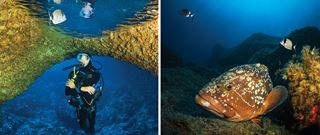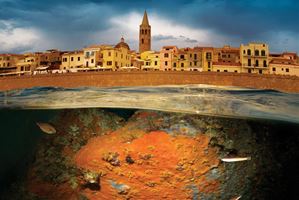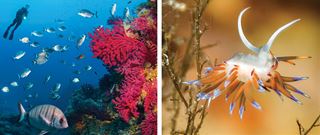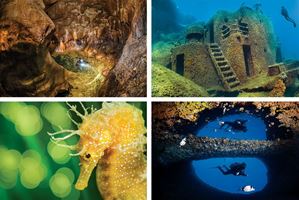There's plenty for scuba divers to see off Sardinia's coast – and even more Italian charm awaits onshore. By Antonio Busiello

Italy is known for its art, food, history and lifestyle. However, not many know that diving in Italy is as alluring as the rest of its attractions. This past summer, I returned to my native country to spend a few weeks in Sardinia, one of my favorite European diving destinations. With more than 1,100 miles of coastline, it ranks as the second-largest island in the Mediterranean, after Sicily, and has numerous underwater sites that provide an array of diving from beginner to advanced, including caves, archaeological and fossil remains, wrecks, big-animal encounters and technical diving. Considered one of Europe´s most beautiful tourist destinations, Sardinia also is renowned for its nightlife; luxurious, star-studded Costa Smeralda; and its breathtaking landscape and amazing white-sand beaches, which alternate with huge granite formations that fall straight into the sea. Colors range from emerald green to dark blue, with all shades in between: turquoise, cobalt and more. Visitors are reminded of the Caribbean but with amazing Italian cuisine — what a combination!

Alghero, on the northwest coast, is known for its Catalan Gothic architecture. Antonio Busiello
Tavolara and Punta Coda Cavallo
Located south of world-famous Costa Smeralda, Tavolara and Punta Coda Cavallo became a marine protected area in 1997. Snapper, jacks, octopuses, big schools of Mediterranean chromis and colorful ornate wrasse can be seen here, even by snorkelers. Papa Banks Papa Bank 1 and 2 are divided by a sand channel on the east side of the small island of Tavolara. The first bank starts at 50 feet and goes to nearly 120; the second starts around 90 feet and ends on the sand at 150. This site is famous for its Paramuricea clavata, a gorgonian found here in different colors, including a rare yellow and red bicolor variety. It´s common to see big grouper, snapper and jacks swimming around them. It is also possible to see big yellowtail, mobula rays and Mediterranean moray eels along Tavolara´s walls, which are covered by healthy populations of yellow cluster anemones. Molara Wreck Due to its position in the middle of the Mediterranean, Sardinia was on Europe´s most important sea routes for centuries. Every kind of wreck can be found in these waters, from ancient Roman ships to World War II battleships, airplanes and cargo ships. Some are very deep, accessible only by technical diving. The so-called Molara wreck is one of two ships sunk by submarines during WWII just off Tavolara. Recently the wreck was identified as the Oued Yquem, sunk by Netherlands submarine O21 in 1941 while en route from Syria. The massive 230-foot wreck, lying on the sand at 100 to 120 feet, looms out of the blue as divers start their descent, an impressive view. Inside it´s easy to see grouper, big European conger eels and sometimes lobsters. Outside there are always schools of saddled sea bream, red mullet and snapper. Il Grottone With a max depth of 45 feet, this could be the perfect afternoon dive, a great ending to a day in Tavolara. Under the cliffs, a large shallow cavern, 65 feet wide and 50 feet tall, offers a spectacular scene. Its large dimension allows sunlight in; divers can admire colorful algae and sponges that cover every inch of the inside walls. Outside the cave is a parade of big grouper, moray eels, octopuses, lobsters and big schools of small reef fish such as chromis, saddled sea bream, rainbow wrasse and beautiful ornate wrasse, probably the most colorful fish in the Mediterranean.
 The stunning gorgonians of Papa Banks (left); a nudibranch at Il Grottone. Antonio Busiello
The stunning gorgonians of Papa Banks (left); a nudibranch at Il Grottone. Antonio Busiello
Capo Caccia Caves
On the west coast of Sardinia, facing the sea from behind its ancient brick walls, lies Alghero, a beautiful fishing village. A mandatory stop on this side of the island, it´s the perfect place to enjoy a cocktail as the sun sets in front of the majestic Capo Caccia cliffs. Capo Caccia is the most important underground cave system in Italy, with some of the biggest underwater caves in Europe. Huge limestone cliffs fall straight into the sea, dotted with more than 100 caves that create this impressive coastline. This karst system offers several diving opportunities at different depths. These caves are millions of years old; some are connected via above-water caves adorned with beautiful stalagmites, stalactites and fossils dating back more than 100,000 years. Additionally, this area contains one of the few places in Italy where divers can view red coral at only about 30 feet.
Nereo´s Cave
This cave, named in honor of a mythological figure also known as the Old Man of the Sea, is considered the biggest marine cave in the Mediterranean. It´s a huge connected system of arches, tunnels, air chambers and caves that extends deep into the mountain. Nereo´s Cave has many entrances, making this dive different every time. The deepest is at about 100 feet, where a long tunnel leads to a huge room illuminated by external light, creating spectacular effects. Other entrances and exits can be found around 50 to 60 feet, especially a “heart”-formed opening at 60 feet, best viewed from the inside. Some of the tunnels are connected with open water, allowing sea currents to bring life and nutrients into the cave. Some of the walls are covered with red coral and yellow leptopsammia cup coral, and pretty much everywhere it´s easy to spot congers, slipper lobsters, Pagurus hermit crabs and golden coral shrimp.
Falco´s Cave
This cave was named in honor of Ennio Falco, a great freediver and record holder in the ´60s. The cave walls and arches are covered with sponges and every kind of cave sea life including red coral. Snapper and grouper swim in proximity to the entrance, offering a pre-show before the real attraction. From Falco´s Cave, it´s possible to access a dry cave, where divers can leave their equipment and walk around in a spectacular atmosphere of walls, arches, stalactites and stalagmites, all illuminated in divers´ lights.
 Clockwise from top left: Divers emerge from Falco´s Cave; the Angelika wreck was dashed on the rocks of Marmorata; Nereo´s Cave has many entrances; a seahorse at Capo Galera. Antonio Busiello
Clockwise from top left: Divers emerge from Falco´s Cave; the Angelika wreck was dashed on the rocks of Marmorata; Nereo´s Cave has many entrances; a seahorse at Capo Galera. Antonio Busiello
Deer Cave
Just like Falco´s, this cave leads to a dry cave, smaller than Falco´s but with a very interesting attraction. Attached to the main cave, there is a smaller one separated by an arch; at the end of this little cave, a deer fossil dating back more than 100,000 years is visible, a great memory from a unique spot.
Archipelago di La Maddalena National Park
Established on April 1, 1994, this national park includes many little islands between Sardinia and Corsica. Locals say this is an extension of heaven on earth, and after visiting the archipelago, I must agree. The water is so clear and transparent that it becomes hard to describe. Red and yellow rocks emerge from light-blue water that splashes on extremely white or pink sandy beaches, creating a feast for the eyes. Worth visiting are Pink Beach, Cala Coticcio and Cala Soraya, to name just a few. The marine park includes more than 30 dive sites accessible only by authorized dive centers. Abundant life, even in shallow waters, offers a great dive experience to any level of diver.
Lavezzi, the Grouper City
For decades Lavezzi has been known in the Mediterranean as Grouper City. Here it´s possible to dive with huge, friendly grouper that get very close and can follow divers for pretty much the entire dive. This spot is a few miles north of the archipelago in the Bocche di Bonifacio National Park and attracts divers from all over Europe. Depth is between 80 and 100 feet, and the bottom is full of big rocks covered with Paramuricea clavata and yellow cluster anemones (Parazoanthus axinellae). Sea life here is very abundant — big snapper, sea bass, jacks and schools of barracuda are very common, just like the grouper.
Clan Ogilvie Wreck
What an amazing experience it is to dive a wreck that has been on the bottom of the ocean for 130 years. Clan Ogilvie was built by the English company Stephen & Sons in 1882 and sank in 1888. This is not an easy dive because the wreck lies on the bottom at 170 feet and currents can often be strong. The wreck is completely covered by sponges and gorgonians — some of the biggest in the archipelago — and is surrounded by an amazing show of big fish such as grouper, snapper, yellowtail, big lobsters, and moray eels.